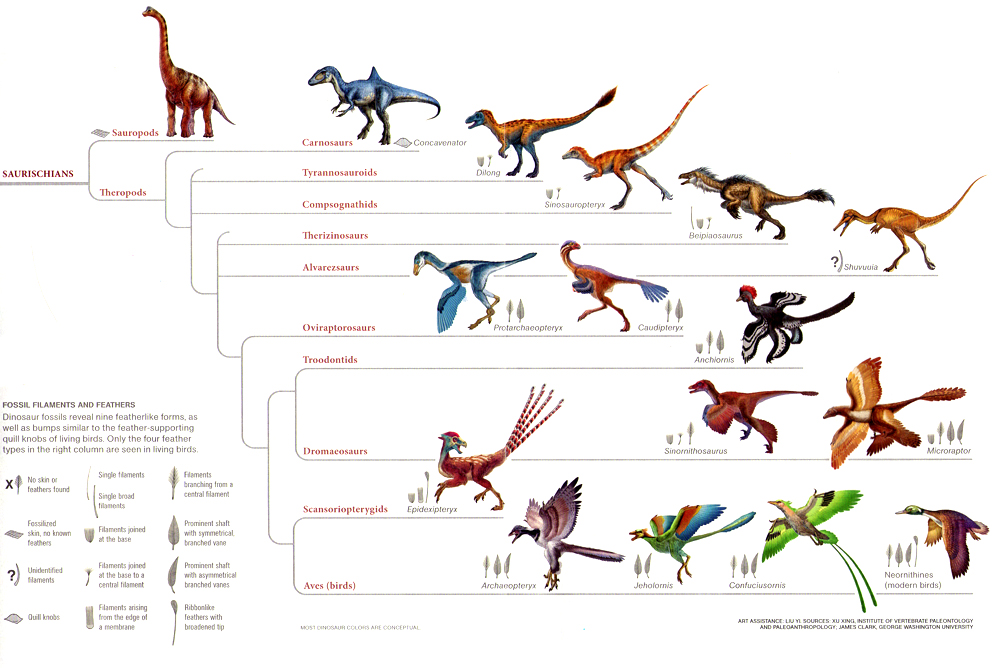
| Palaeos |  |
Coelurosauria |
| Vertebrates | Index |
| Page Back | Unit Home | Unit Dendrogram | Unit References | Taxon Index | Page Next |
| Unit Back | Vertebrates Home | Vertebrate Dendrograms | Vertebrate References | Glossary | Unit Next |
|
Abbreviated Dendrogram
DINOSAURIA |--ORNITHISCHIA `--+--SAUROPODOMORPHA `--THEROPODA | `--COELUROSAURIA |--Tyrannosauroidea `--+--Ornithomimosauria `--+--Maniraptora |--Therizinosauroidea `--Metornithes |--Alvarezsauridae `--+--Oviraptorosauria `--Paraves |--Deinonychosauria | |--Troodontidae | `--Dromaeosauridae `--Avialae |--Scansoriopterygidae `--AVES |
Contents
Index |
Neither dinosaurs (using the colloquial, paraphyletic, definition) nor true birds[1], but perfectly intermediate and transitional between the two, the coelurosaurs or feathered dinosaurs, appeared during the late Jurassic, becoming a major part of terrestrial faunas in the Middle and Late Cretaceous, when they co-existed with both conventional dinosaurs and the first representatives of true birds. They constitute a highly diverse group of theropods that include everything from giant tyrannosaurs to swift-running ornithomimids and even and even ground sloth mimics. They include carnivores, omnivores, and herbivores, tree dwellers, gliders, powered flyers, and all manner of terrestrial forms. But the most extraordinary thing about them, only revealed in the last two decades through beautifully preserved Chinese specimens, is the presence of feathers. In life these creatures would have looked nothing like the scaly monsters of fantasy, and everuything like extraordinary, long-tailed, flightless (and sometimes even flying) birds. The following dendrogram by Carl Zimmer maps out the origin and evolution of feathers as revealed through fossils and cladistic analysis, and gives a good overview of the Coelurosauria, not as dry bones but as living animals.

Family Tree of Coelurosaurs (feathered dinosaurs). Artwork by Xing Lida, from Zimmer, 2011), via Fantasy Game Book, Feathered Dinosaurs and the Dinosaur Lag Effect. Anchiornis (above) can be seen at the middle right
In this unit we will consider these various groups (some more comprehensively than others, at the current time of writing) before moving on to orther dinosaurs. Although this may not be the most logical approach, the problem with a linear review is that it is not always possible to follow the branching path of evolution. The latter in this case involves the nested clades of Dinosauria --> Theropoda --> Maniraptora --> Aves (True Birds). But we still haven't considered the spectacular sauropods and the diverse and specialised ornithischians; in the following two units they are reviewed, before the narrative returns to avian evolution MAK120310
Notes
[1] We are aware of course that cladistically speaking, birds are a specialised sub-set of dinosaurs, in which case the opening sentence of this page would be misleading. On the other hand, evolutionarily speaking, birds are the descendents of the dinosaurs;in which case the opening sentence makes total sense. Cladistically, if dinosaurs are to be a natural (monophyletic) taxon, birds need to be included, otherwise dinos would go the way of the reptiles, a 19th century taxonomic anachronism of no more than colloquial usage. For the evolutionary gradist in contrast, ancestral taxa are not a problem. Hence dinosaurs evolve into birds. Ultimately though, it doesn't matter which taxonomic, systematic, or phylogenetic paradigm or classification system one prefers; it's the same evolutionary family tree of Life on Earth. Because all these different perspectives contribute to the big picture, there is no need to be rogorous about obnly one. For this reason, the narrative on Palaeos tends to jump rather haphazardly from one paradigm to another, depending on who the writer is, or even the mood of the same writer; we are less concerned with phylogenetic or taxonomic rigour than with conveying the wonderful and awesome story of the history and evolution of life.
| Page Back | Unit Home | Page Top | Page Next |
page MAK120210